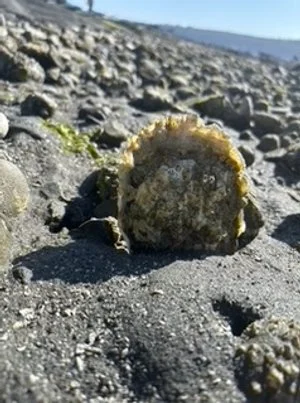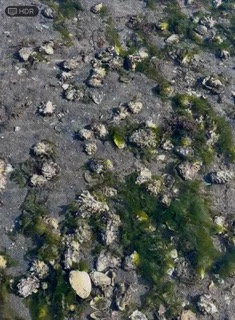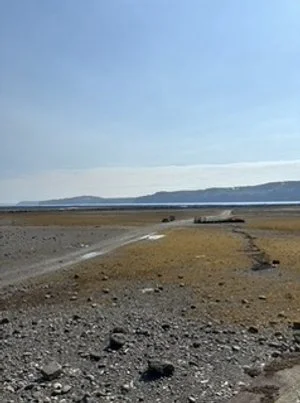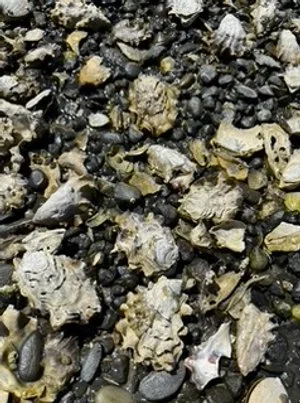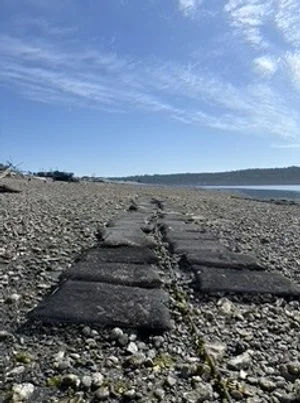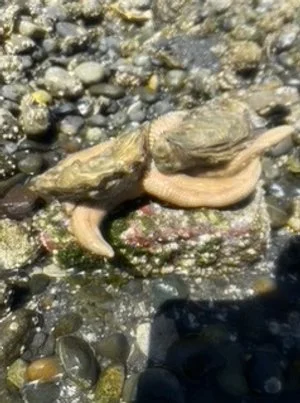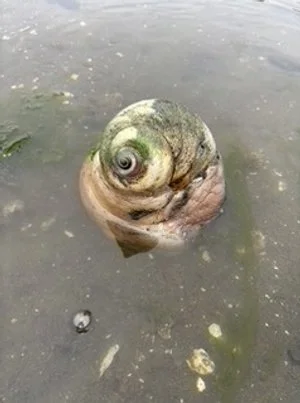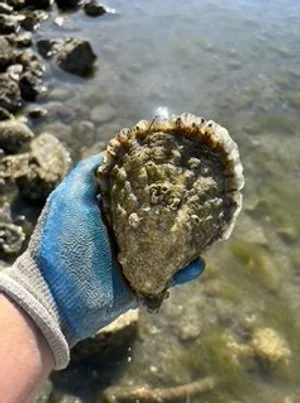Posts from the Pier: Trevor Vick at Hama Hama Oyster Company
Written by Trevor Vick, an Oyster South Peer to Pier Recipient
Jesus! This Water Is Cold!
An intern’s account of all that has been learned after two-months living in Washington.
“I was 19-years-old before I learned a blue heron was called a ‘blue heron.’ We always called them shitaquarts.”
“Chitacourts?”
“Yeah, because they shit-a-quart. My fourth-grade teacher didn’t like that one too much.”
-A conversation between two coworkers and myself.
When moving to a new place, it’s important to learn the language, the culture, and why things are the way they are. While living in Florida, for example, I learned the people of Wakulla county referred to the dark-brown algae that grows on the farm’s Zapco lines as “gumbo” and oysters are sold in increments of one-hundred. In my new home of Washington, oysters are sold by the dozen- a typical sack containing ten-dozen- and seaweeds retain their more scientifically recognized names of “ulva” and “kelp.” Until there’s a plethora of if on your gear and oysters, then it becomes “bullshit,” “shit,” “crap,” or just “a pain in the ass”.
An oyster sorter/tumbler seems to take on the name of the activity it is used for the most. In Florida, it was a tumbler because its primary function was knocking the lip off and shaping the oysters. Here, it is a sorter because we only use it to sort- shaping is done by the tides. Oyster farms in Washington are regulated by the Department of Health while farms in Florida deal with Florida Department of Agriculture and Consumers Services (FDACS). Beaches in Washington close to harvest when the water temperature hits seventy degrees. If this were the case in Florida, oysters would only be pulled out of the water in mid-January.
The smaller farms in Florida I worked for would create oyster brands based on size. Dewey and Jody Houck of Cypress Point Oyster in Florida use the European sizing-model to distinguish their three brands. Euro #5 (Little Honey) being their smallest size, #3 (Summer Salt) being their largest, and everything in between is an Otter’s Choice (#4). Cainnon Greg of Pelican Oyster has two sizes- Salty Birds, his iconic cocktail oyster, and Big Gulps, an oyster grown for the grill or people with big throats and little inhibition.
Here, an oyster becomes its own brand based on growing style, the body of water it is grown in, and species (different sizes available for some brands). Hama Hama’s northern beach in Port Hadlock produces Summer Stones and Summer Blues. Stones are beach-cultured and Blues are reared on a tumble farm. The “summer” designation is given to it because they are grown in the waters around Skunk Island in Port Townsend Bay. The colder waters allow for this growing area to remain open during the hotter months while more southerly beaches in the Hood Canal close due to higher temperatures and disease. Essentially, the entire north farm is a summertime contingency plan for Hama Hama.
Beach culture is historically the most popular style of growing oysters in Washington, but, what is beach culture? To put it as plain and simple as one can, you throw oysters on a beach- come back and pick them up later. A practice that goes against everything I was taught in Florida. The farms I worked in Wakulla county along with their neighbors avoided any sort of bottom culture- to the point where I thought it was forbidden. Turns out this is not the case. You can bottom culture, just know one wants to on account of the horrendous biofouling and predation you deal with. John Harley of Serenoa Shellfish is the only person in Wakulla county (that I know of) that has experimented with bottom culture and it was all for restorative purposes, not for retail.
Beach culture produces an oyster that is aesthetically unique, unlike the uniformity and predictability of oysters that have been regularly tumbled. Each oyster has ripples of shell emanating from that tiniest point by the hinge that used to be the whole of the oyster. A mollusks interpretation of the rings of a tree or blooming petals on a flower. Not long and bladed like wild oysters that have to compete for their resources. Rather, these are plump and nicely cupped from a life of curated indulgence. They are said to have a firmer meat and a higher salinity than their bagged, subtidal counterparts.
Why does beach culture work in Washington? Extreme tides and a history of legislation that promoted the oyster industry in its early days. The tides in Washington were broken down to me as such: there’s a high-high tide (as high as +16ft), a low-high tide, a high-low tide, and a low-low tide (as low as -3ft). The low-low tide is key for beach culture. Here the water recedes and reveals what sometimes looks to be almost a quarter-mile of previously inaccessible land. This allows the farmers here to walk out (sometimes drive a truck) into the tidal area and tend to their oysters. The tides also provide a built-in desiccation schedule- working out their tasty little abductors and providing a reprieve from the threat of predation.
Little gear is needed for beach-cultured oysters. On the Skunk Island farm, we raise our seed in Flip Farm lines until the little fellas aren’t snack-size for predators (technically makes this “bag-to-beach”). Then, we spread them in the lagoon and wait for them to hit market size. When they are ready to be sold, a team- referred to at Hama as the “beach crew”- walks out on low tide and performs that back-straining task that bonds us shellfish farmers with our terrestrial brethren: picking. Oysters of a similar size are picked up off the beach by hand- this is the preferred method of harvesting because it leaves the beach intact, unlike dredging. They are then bagged up in 10-dozen counts and attached to a line to be picked up by boat when the tide comes back in. These bags of oysters are placed in a sink float to purge for 5 days before heading to market.
This, however, does depend on the beach. At Skunk we have a nice lagoon that protects the oysters from strong winds and violent waters. What happens when you don’t have that? Hama’s other northern beach is in Discovery Bay. Discovery Bay, or “Disco” for short, has strong winds and an army of hungry crabs. If oysters are left out on the beach they get blown around and lost or crunched by ravenous red rock crabs. Here, oysters are placed in lay-flat bags and clipped on to lines that are anchored to the rocky substrate.
Knowing your beach is everything when it comes to beach culture. Familiarity with predators, substrate, and water flow proves to be invaluable when deciding where to spread your oysters. One part of your beach might produce more barnacles than an other. Predatory moon snails, crabs, and starfish may be lying in wait in your subtidal areas. Ulva might be so thick that it smothers your oysters. Burrowing shrimp- an invasive species- and their burrows might be present in such volume that the mud start to cave in on itself- causing your oysters to sink into the substrate and suffocate.
The higher up the beach you spread your oysters, the slower they will grow. The lower you spread them, the more biofouling and predation you will see. Typically, when spreading your oysters, you take into account all of these factors plus density. Measured in “oysters per square foot” your spread is how you control your density and, in turn, shape your oyster.
What has the state done to encourage beach culture and oyster farming as a whole? First, one must understand the cultural significance of the oyster in Washington. For thousands of years before the arrival of Europeans, the indigenous Salish peoples practiced aquaculture. Ditches would be dug in the shoreline that would trap water as the tide went out. This allowed them to hold their oysters and clams in one place and protected the fragile Olympia oysters from the scorching summer sun or cruel winter winds. It can be theorized that these ditches were also the first hatcheries in North America seeing as the spat of an Olympia oyster broods within the female’s mantle for 7-10 days. Pretty cool to think that North America had its own Sergius Orata in the Pacific Northwest.
Many years after the arrival of Europeans, on February 27th, 1854 the first meeting of the Washington Territorial Legislature took place. At this meeting, legislators would pass an act that would prohibit anyone that was not an inhabitant or resident of the territory from harvesting oysters from local beds. This was the beginning of two legislative trends in Washington: one that had a vested interest in encouraging oyster industry and another that was pure xenophobia.
Washington became a state in 1889. Six years later, in 1895, the most important two acts in state oyster history were passed within days of each other. The Bush Act and the Callow Act, gave individuals who owned property abutting the water the option to buy up to 100 acres of tideland for $1.25 per acre specifically for growing oysters. The main difference between the two acts was that the Bush Act (passed first) stated that if the purchased tideland was used for anything aside from farming oysters, the state could reclaim the land. The Callow Act amended this and stated that reversion to the state can happen for any reason and at any time.
47,000 acres of tideland were taken out of the Public Trust and sold under the Bush and Callow Acts. While being controversial for restricting public access to tidelands that many believe should be open to everyone, this gave oyster farmers a precious resource: land ownership. Farmers now had collateral to get bank loans and expand their farms.
Another controversy that came about after the passing of the Bush and Callow Acts was the selling of tribal tideland without consent. Despite having signed treaties in 1855 that ensured rights and access to heritage fishing waters- indigenous peoples were prohibited from harvesting shellfish on tidelands that were sold out form under them. This wasn’t resolved until 1974, when the Boldt decision granted indigenous nations 50% of Washington’s total seafood harvest and gave them $33 million dollars to buy back their tidelands.
Ironically, only about 5-10 years after the passing of the Bush and Callow Acts, the Olympia oyster went into heavy decline. Not because of over harvesting- but pollution. Washington’s lumber industry in the early 1900’s was a force to be reckoned with and it began to butt heads with oyster farmers. With lumber came pulp mills that left the waters polluted and killed off many of the oysters on farms and in the natural beds. The oyster industry hit a holding pattern for several years, until the introduction of the Pacific oyster.
The first commercially viable transplant of oysters from Miyagi Prefecture to Samish Bay took place in 1919. J. Emy Tsukimato and Joe Miyagi were two Japanese men born, raised, and educated in Olympia, Washington. Having spent their summers working on oyster farms in Oyster Bay, both men were well acquainted with the craft. The two men plus 6 business partners purchased a farm called Pearl Oyster Company on 600 acres of land with the intent to try something radical: growing a new species of oyster.
Tsukimato and Miyagi were not the first to try to transplant oysters from Japan. In fact, the first attempt had taken place over a decade and a half before in 1902 with oysters from Hiroshima. Only a few of these survived their journey. Over the next few years leading up to 1919 many more attempts were made- different combinations of factors exhausted. Waters of origin, location of replanting, how they were transported, and what time of year were all experimented with by Japanese immigrants- until eventually, success. Tsukimato and Miyagi imported 400 cases (each case being around two bushels) of larger oysters from Miyagi Prefecture. While the larger oysters themselves didn’t do well on their 20-day journey across the Pacific, all of the spat clinging to the shells flourished in Samish Bay. Growing faster and larger than in their home waters.
Unfortunately for Tsukimato and Miyagi, the state of Washington passed the Alien Land Law in 1921, making it illegal for them to own any acreage. This law was primarily aimed at Japanese immigrants who at the time made up a significant part of the agricultural population of the state. With this new law in effect and growing aggression towards the Japanese from white citizens, the two entrepreneurs and trailblazers were forced to sell.
Pearl Oyster Company was sold May, 18th 1923 to E.N. Steele and a business partner. E.N. Steele at this time was already an established Olympia oyster farmer with property along the Hood Canal. He was a board member on the Olympia Oyster Grower’s Association and later helped found the Pacific Oyster Grower’s Association. Upon purchase, Pearl Oyster Company became the Rock Point Oyster Company (named after a rocky point that protruded out into the bay east of the oyster beds). A few months later in September of 1923, the oysters that Tsukimato and Miyagi had planted were sent to market for the first time. Tsukimato went on to act as a seed buyer in Japan for farms in Washington.
With the successful establishment of the Pacific oyster, Washington’s diminishing market was replenished. Pacific oysters were large enough in size to compete with oysters shipped in from the east and- due to locality- cheaper for west coast restaurants to purchase. Some clever marketing had to be done by Steele and family to get consumers to bite. They came up with: “Look for the oyster with the velvet rim. It assures you that it is grown in the pure waters of the Puget Sound, and that it is fresh. It has a velvet rim the same as the Olympia oyster.” The “velvet rim” refers to a dark line that runs along the perimeter of the mantle. Initially, people were put off by this, thinking there was something wrong with the oyster. Rock Point Oyster company turned this perceived flaw into an identifying mark of quality.
E.N. Steele wrote a book on the introduction of the Pacific oyster into Washington waters called, “The Immigrant Oyster.” In it, he describes the oyster’s transplantation into the state’s waters and marketplace as well as its continued history into the Great Depression and World War Two. He also gives full credit to Tsukimato and Miyagi as the first two men who successfully transplanted a commercial harvest of Pacific oysters in Washington. E.N. Steele would spend the rest of his life working tirelessly to promote the Pacific oyster and is now considered the “Daddy of the Pacific Oyster Industry.” Rock Point Oyster Company still exists today, however, not in Samish Bay- they are now based in Dabob Bay.
Now Washington State accounts for 25% of the nation’s shellfish, with the annual harvest reaching over an estimated $270 million and employs over 3,200 people. State assistance comes in many forms: the Washington State Department of Agriculture was approved $650,000 in research grants for burrowing shrimp management by state legislature. Washington Sea Grant holds classes for aspiring shellfish workers to further their training and education in the industry. The Washington Shellfish Initiative works to promote and preserve clean waters and suitable shellfish growing habitat. All of these play a crucial role in the continued success and longevity of Washington’s shellfish industry.
Aquaculture history can reveal to us what steps need to be taken to ensure a future for this industry. My hope is that Florida can look at the process Washington went through to build its industry and, not emulate, but improve upon it. The first thing I would encourage Floridians to do is take whatever steps necessary to preserve working waterfront from the constant onslaught of development that plagues the state. More farmers need the opportunity to own property instead of renting slips or trailering their boats to the water every day. Hopefully this will help banks look at farmers with a kinder eye as they consider loan applications.
Another wish of mine is that more Florida farmers will come together and work in solidarity to expand the industry. There are a lot of lone wolves out there… and I get it. The dream for many is not to have a boss while also not having to be anyone else’s boss. Just you, your oysters, and the water. It’s a noble ambition, but can only be kept up if one is willing to leave their peaceful solitude to talk about what the industry needs to survive.

